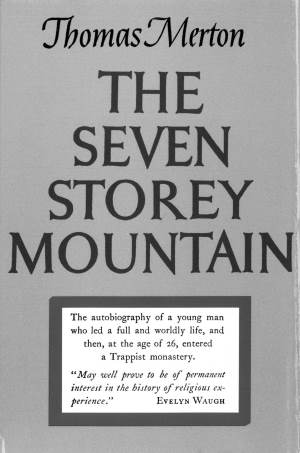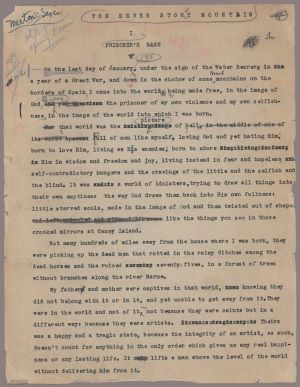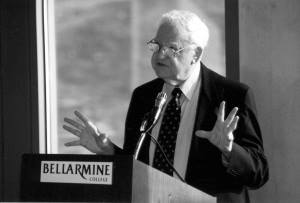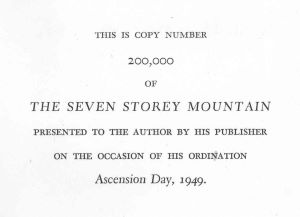The year 2023 marks the 75th anniversary of the publication of The Seven Storey Mountain.—Editor
By Paul M. Pearson, Ph.D.
Robert Giroux, one of the great American editors of the second half of the twentieth century, edited works by 10 Nobel Prize winners, including Hermann Hesse, T.S. Eliot, Pablo Neruda, Isaac Bashevis Singer, Derek Walcott, William Golding and Seamus Heaney, along with five books that won the Pulitzer Prize and 10 books that won the National Book Award. Yet, the best-selling book of Giroux’s career won none of these awards and was a most unexpected success.
The Seven Storey Mountain first appeared in print in America in October 1948, seven years after its author, Thomas Merton, had entered the Trappist monastery of Our Lady of Gethsemani in rural Kentucky on Dec. 10, 1941.
The planned print run was 5,000 copies. In its first year in print, The Seven Storey Mountain sold more than 600,000.
In the years before Merton entered Gethsemani, he had worked very hard to get his name into print, sending his poetry to a variety of literary magazines and his novels to a number of publishers, though he seems to have been more successful in reviewing books for newspapers, with 11 of his reviews appearing in The New York Times Book Review and The New York Herald Tribune Book Review between May 1938 and the beginning of 1940.
On entering Gethsemani Merton did not expect to continue writing but was encouraged by his spiritual director to continue writing poetry. Even while Merton was still a novice, his abbot, Dom Frederic Dunne, encouraged him to undertake some translations and biographies of Trappist saints, along with some works about Cistercian life, so as to spread knowledge about the order in the United States, to encourage vocations, and to generate some income for a desperately poor monastery.
The grave financial issues the monastery faced were evident in an interview with Naomi Burton, Merton’s literary agent, where she recalled that the publisher, Harcourt Brace, advanced the monastery $1,000 on Merton’s autobiography as they were in such terrible financial straits. Similarly, in a letter to Raymond Flanagan from October 1948, Merton wrote of the providence of God getting “the book published just when Rev. Father needs dough.”
Ultimately the abbot both allowed and encouraged Merton to write his autobiography. With the publication of The Seven Storey Mountain, Merton paradoxically achieved the bestseller status that he had yearned for before his entry to the monastery but had not at that stage achieved.
Merton’s writing of The Seven Storey Mountain is not out of character; its novelty would lie in its emanation from Trappist silence, its phenomenal success, and the book’s mass-market appeal. Time magazine, in early 1949, reported that people were reading and discussing the book “from the sedate lending libraries of New England to the bustling women’s clubs of the West Coast.”
‘A General Hallucination’
 An autobiography is frequently the work of an older person who believes they have accomplished the major work of their life and is then reflecting on their life from a position of retirement, often with death approaching.
An autobiography is frequently the work of an older person who believes they have accomplished the major work of their life and is then reflecting on their life from a position of retirement, often with death approaching.
When Merton was writing The Seven Storey Mountain in 1946, he was in his early thirties, just eight years after his reception into the Catholic Church and only five years since his joining Gethsemani. Yet he obviously felt his life as a monk gave him a perspective on his life, a standpoint from which to look back at it.
Dante’s Divine Comedy provided The Seven Storey Mountain with not just its title but with its allegorical form as well. Merton’s autobiography, as with all the other journals, books and volumes of poetry that he saw through to publication in his own lifetime, is both carefully and highly structured, following the structure and mythological framework of The Divine Comedy.
The Seven Storey Mountain is divided into three parts, each mirroring the hell, purgatory and heaven of Dante’s book, and Merton tells his story in the form of Dante’s famous journey, the journey from hell through purgatory to paradise, an ascending journey moving from the “unreal city” incarnated for Merton in Cambridge, London, and New York to the paradise of the cloister at Gethsemani, “the real capital of the country.”
Although later in his life Merton disowned his autobiography as no longer belonging to him, he made no attempt to revise it. In the mid-Sixties, at the request of a local high school student, Merton compiled a graph evaluating his books. Even though he says that his autobiography had “created a general hallucination,” and turned him into “a Catholic myth for children in parochial schools,” he still rates it as one of his “better” books, the highest rating he gives to any of the books he wrote. Thus, in Merton’s reckoning as well as in his reader’s perception of the book, it remains quintessential to the Merton canon.
Publishing the Mountain
In numerous presentations and interviews over the years, Robert Giroux has spoken about his work of editing The Seven Storey Mountain and the extraordinary success of the book. As already mentioned, Merton had submitted other manuscripts for publication prior to his entry to Gethsemani in 1941 and had used the services of Naomi Burton who, at this time, was working for the Curtis Brown Literary Agency.
His pre-monastic novels, all semiautobiographical, had found their way into the hands of Giroux, who was working at Harcourt Brace. Giroux, like Merton, a graduate of Columbia University, had edited The Columbia Review and his first contact with Merton was when Merton submitted essays to The Review.
It is in a March 1946 letter to James Laughlin, the founder of New Directions and the publisher two years earlier of Merton’s first book, Thirty Poems, that Merton’s earliest extant reference to The Seven Storey Mountain occurs: “Rev. Father just okayed a new project—creative, more or less poetic prose, autobiographical in its essence” which, Merton writes, had “been brewing for a long, long time.”
 Merton suggests that he would like to “keep it down to about one hundred and fifty pages.” However, five months later he would write to Laughlin again, saying that it had now grown to over 650 pages, turning into the mountain suggested by the title. Merton eventually mailed the manuscript to Burton on Oct. 21, 1946, though it would not be forwarded to Robert Giroux until mid-December.
Merton suggests that he would like to “keep it down to about one hundred and fifty pages.” However, five months later he would write to Laughlin again, saying that it had now grown to over 650 pages, turning into the mountain suggested by the title. Merton eventually mailed the manuscript to Burton on Oct. 21, 1946, though it would not be forwarded to Robert Giroux until mid-December.
Laughlin recalls that the manuscript of The Seven Storey Mountain was also sent to him, but that he delayed looking at it as he was departing on a skiing trip. This was probably providential for Merton; it would have been very unlikely that the book would have become the success it did if it had been published by New Directions, as the press lacked the vigor and reputation of Harcourt Brace, along with its sales and marketing capability.
After receiving the manuscript, Giroux read it immediately and recommended its publication to Donald Brace. It was an unusual title to be published by a trade house at that time as, according to Burton, Catholic authors as a rule were published by Catholic publishers with one major exception: Graham Greene. Giroux’s recollection of his conversation with Donald Brace, his senior editor and founding partner of Harcourt, Brace and Company, clearly demonstrated the unexpected nature of The Seven Storey Mountain’s success. Giroux recalled:
 I told Mr. Brace this was a manuscript by a former classmate of mine and that it was about his conversion to Catholicism and his going into a Trappist monastery, he said, ‘you really like it?’ And I said, ‘yes, it’s really very readable.’ … he said … ‘You don’t think it will lose any money if we publish it, do you?’ And I said, ‘I really don’t think we’ll lose any money, but whether we’ll make any is problematic.’
I told Mr. Brace this was a manuscript by a former classmate of mine and that it was about his conversion to Catholicism and his going into a Trappist monastery, he said, ‘you really like it?’ And I said, ‘yes, it’s really very readable.’ … he said … ‘You don’t think it will lose any money if we publish it, do you?’ And I said, ‘I really don’t think we’ll lose any money, but whether we’ll make any is problematic.’
On Dec. 29, 1946, Giroux sent a telegram to the monastery saying simply: “Manuscript accepted. Happy New Year.” Merton obviously agreed with Giroux that his autobiography would not make a great deal of money, writing to Raymond Flanagan, a fellow monk and author, in October 1948: “It won’t make enough dough to build even one wing of a Quonset [hut] monastery, but it may help.”
In preparation for taking his solemn vows at the monastery on March 19, 1947, Merton completed his will, which was signed and witnessed on Feb. 17, 1947, solemnly swearing to “give and bequeath” to the Abbey of Gethsemani “all my estate both real and personal which I at present possess and also any estate both real and personal to which I may have any right, title, interest, or claim hereafter.”
Later the very same day, Merton would return to the abbot’s office to sign the contract for The Seven Storey Mountain.
Mounting sales
Initially the planned print run was 5,000 copies, which would have been the break-even point for the publisher. Yet, before its publication date, October 4, 1948, the print run had been upped significantly. The main impetus for this was Giroux’s decision to send galley proofs to four people he considered to be the most important readers of this book: Evelyn Waugh, Graham Greene, Clair Booth Luce and Bishop Fulton Sheen. All four responded quickly and positively. The book had also been adopted by three Catholic book clubs, leading to the print run being upped to 20,000.
In its first year in print, The Seven Storey Mountain sold more than 600,000 copies in hardback. Bookstores would telephone the publisher, according to Naomi Burton, questioning the whereabouts of their orders only to find out the books had already been both delivered and sold.
 To celebrate the publication of the 100,000th copy, Burton told one interviewer that she went with Giroux to Giovanni’s Restaurant where they had seven-layer chocolate cake to celebrate. After Merton’s ordination to the priesthood on May 26, 1949, Giroux presented him with a specially bound and engraved copy, the 200,000th copy to come off the press.
To celebrate the publication of the 100,000th copy, Burton told one interviewer that she went with Giroux to Giovanni’s Restaurant where they had seven-layer chocolate cake to celebrate. After Merton’s ordination to the priesthood on May 26, 1949, Giroux presented him with a specially bound and engraved copy, the 200,000th copy to come off the press.
Initially the book didn’t appear on The New York Times’ bestseller list, as many of the bookstores reporting the sales on which the list was based did not include “religious books” and certainly not “Catholic books.” Harcourt Brace therefore took out a full-page advertisement in The New York Times challenging its bestseller list and The Seven Storey Mountain’s position on it.
The book entered the list on Dec. 19, 1948, and was continually on the bestseller list for every single week of 1949 and on into 1950. Although it spent many weeks at No. 2 on the list it never made the top slot.
Upon its publication in May 1949, Merton’s Seeds of Contemplation, published by New Directions, appeared briefly on the list, and then in the fall of 1949 The Waters of Siloe, also published by Harcourt Brace, entered the list and remained there for the remainder of the year, frequently sharing a neighboring position with The Seven Storey Mountain.
Merton’s prominence on the bestseller list led the renowned New York Times book reviewer, Charles Poore, to have one of his characters quip in a Dec. 31, 1949, story that “the 10 outstanding books of the 1950s… will mostly be written by Thomas Merton.”
Why was The Seven Storey Mountain so successful?
We can get some idea of the reasons for the phenomenal success of The Seven Storey Mountain from the advertisements Harcourt Brace was taking out promoting the book, asking “Why are these two bestsellers—The Seven Storey Mountain and The Waters of Siloe—the most talked about books in America?” Their advertisements suggested, based on reviews, that:
- they take account of our deep spiritual hunger;
- thousands of us want to know why men become monks and what it is like to live inside a monastery;
- they are fascinating reading.
Those suggestions are all certainly valid but, with hindsight, other more important reasons can be added. Certainly the quality of the author’s writing was important, but perhaps more important was the period in which the book was published, a factor of timing that neither Merton nor Giroux could have truly anticipated. James Laughlin, speaking of this aspect, said:
"The Seven Storey Mountain has something to say that people were at that moment in our social history ready to hear. It presented an answer to spiritual problems that many people, particularly young people who were upset by the way things were going in the country, who were upset by the threat of the atomic holocaust and all the rest of it. They wanted to hear that and they liked the way Merton put it, so simple and direct."
Reflecting many years later, Giroux would say that the book owed its success to three things: It appeared “at a time of disillusion, following the Second World War, when another war—the Cold War—had started and the public was ready for a change from disillusion and cynicism.” Secondly, Merton’s story was unusual: “An articulate young man with an interesting background leaves the world and withdraws into a monastery.” And thirdly, it was well written, “a tale well told, with liveliness and eloquence.” This combination of the “right subject at the right time presented in the right way,” according to Giroux, “accounts for a good part of the book’s success.”
As succeeding generations have continued to struggle to find meaning in the face of issues and problems, Merton could never have imagined that his autobiography would continue to offer a countercultural option, an alternative, spiritual approach to living.
As one reviewer of the 50th anniversary edition of his autobiography wrote, Merton “transformed the tale of the Prodigal Son into a literary thriller—jazzed up, powerfully narrated, and as impossible to put down now as it must have been a half-century ago.” The book has remained continually in print and has been translated into more than 20 languages, with new translations still being made.
The questions Merton struggled over about the meaning and purpose of life face each new generation, and his story of a man who had embraced all that this world had to offer, who had worked his way through his own problems and had successfully come out the other side, has, as Graham Greene suggested, “a pattern and meaning valid for all of us” in the 21st century, 75 years after the book was first published.
Dr. Paul M. Pearson is director of the Thomas Merton Center at Bellarmine University and chief of research for the Merton Legacy Trust. He is resident secretary of the International Thomas Merton Society and served as its 10th president. This article was excerpted from The Catholic Library Association’s Catholic Library World, Vol. 87, No. 3, which was published in March 2017.